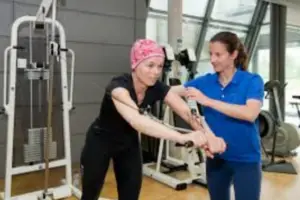
Best workouts and Exercises for individuals with cancer

This content explains the best ways you can get good workouts and exercises during and after your cancer has been treated. This particular information is meant for individuals that have not started exercising or working out at this time.
Endeavor to talk to your doctor before you start exercising. Depending on your personal cancer treatment plan, you might need to abstain from or change some kinds of exercises or activities. If you have been operated upon(surgery), ask your surgeon whether it is advisable to start exercising or working out.
Physical Activity and Exercise for cancer patients

Physical activity is any movement of the body that uses energy. Some of your daily life activities are examples of physical activity. This can be doing active chores around your home, doing yard work, or walking your dog.
Exercise is a type of physical activity. When you exercise, you do body movements that are planned, controlled, and repeated (done over and over). This helps to improve or maintain your physical fitness level. Try to add these physical activities into your daily life. They will help you get many of the health benefits of exercise.
- Activities that make you breathe harder, such as:
- Brisk walking (such as power walking or speed walking)
- Running
- Dancing
- Swimming
- Playing basketball
- Strength training exercises that make your muscles stronger, such as:
- Push-ups
- Sit-ups
- Squats and lunges
- Lifting weights
- Using resistance bands
Best Benefits of Exercise
Exercise may help:
- Lower your risk of getting some types of cancers, such as breast and colon cancer.
- Lower your risk of cancer recurrence (the cancer coming back). This is most important for people who have had breast or colorectal cancer in the past.
- Improve your cardiovascular (heart) health.
- Control your weight and improve your body image. Body image is how you see yourself and how you feel about the way you look.
- Improve your quality of life and mental health.
- Keep your bones, muscles, and joints healthy.
- Improve your ability to do activities of daily living (ADLs). Examples of ADLs are eating, bathing, using the bathroom, and grooming (such as brushing your teeth and combing your hair).
- Keep you from falling.
Before You Start Exercising with cancer
Talk with your healthcare provider before you start any exercise program. They can help you figure out if you have any health problems that may affect which exercises you can do. They may suggest that you get a medical exam or meet with an exercise specialist. An exercise specialist is a person who has special training in physical activity and exercise. This can be a physical therapist, cancer rehabilitation specialist, or certified personal trainer.
The kind of exercises you can do could be affected if you have any of these health problems:
- Unsteady gait (unstable walk).
- Anemia (having a low red blood cell count).
- Very bad fatigue (feeling more tired and weak than usual, or like you have no energy).
- An infection, such as a fever or the flu.
- Not getting enough nutrients or vitamins in your diet.
- Poor bone health or osteoporosis (OS-tee-oh-puh-ROH-sis). Osteoporosis is a disease that makes your bones weak and more likely to break.
- Arthritis (painful swelling and stiffness of your joints).
- Musculoskeletal (MUS-kyoo-loh-SKEH-leh-tul) issues (problems with your muscles and bones).
- Peripheral neuropathy (tingling or numbness in your hands and feet).
- You have an ostomy or central venous catheter (CVC).
- Uncontrolled (untreated) heart or lung disease.
- You had lung surgery or major abdominal surgery in the past. Abdominal surgery is surgery to your stomach, small intestine, spleen, appendix, colon, or rectum.
- Lymphedema in the limb(s) you’re using to do strength training exercises. Lymphedema is swelling that usually happens in the arms, legs, or both. It’s usually caused by lymph nodes being removed.
Suggested Amount of Exercise for cancer
Experts from the American College of Sports Medicine (ACSM) and the American Cancer Society (ACS) suggest you:
- Try to get at least 150 to 300 minutes of exercise at a moderate level of intensity every week. You can do this by exercising for 30 minutes a day, 5 days a week. The table in the “Exercise Intensity Levels” section gives examples of moderate-intensity exercises.
- Aim for 2 to 3 strength training sessions a week. These sessions should focus on your major muscle groups: your chest, shoulders, arms, back, abdomen (belly), and legs. Examples of strength training exercises are push-ups and sit-ups, using resistance bands, and lifting weights.
- Stretch your major muscle groups at least 2 times a week.
As part of a healthy lifestyle, you should do some type of physical activity every day. You should also avoid long periods of not moving, such as sitting for hours at a time.
Exercise Intensity Levels for cancer patients
Exercise intensity is how hard your body is working when you’re exercising. It’s a measure for how hard a physical activity feels to you while you’re doing it. There are 3 exercise intensity levels: light, moderate, and vigorous.
When your healthcare provider says its safe for you to start exercising, try doing light-intensity exercises first. Once you’re comfortable doing those exercises, you can try moderate-intensity exercises, which are more challenging.
Usually, when you’re doing light-intensity exercises:
- You’re not out of breath.
- You do not break out into a sweat.
- You can talk and sing without stopping for a breath.
Usually, when you’re doing moderate-intensity exercises:
- You breathe faster, but you’re not out of breath.
- You break out into a light sweat.
- You can talk but not sing.
This table gives examples of light-intensity and moderate-intensity exercises you can do.
| Light-intensity Exercises | Moderate-intensity Exercises |
|---|---|
| Relaxed biking (slower than 5 miles per hour on flat ground without hills) | Biking (slower than 10 miles per hour on flat ground without hills) |
| Slow walking (slower than 3 miles per hour) | Brisk walking (3 to 4.5 miles per hour) |
| Light housework | Gardening and yard work |
| Tai Chi (an exercise that uses slow movements and deep breathing) | Yoga |
| Playing catch (throwing a ball, beanbag, or frisbee back and forth with a partner) | Doubles tennis (you and a partner play against a team of 2 players) |
| Bowling | Water aerobics |
Starting an Exercise Program as a cancer patient

Think about the reasons why you have not been exercising. Then try to come up with some ways to get past the things keeping you from getting exercise. For example:
- I have not been active in a very long time. Start at a comfortable level and add a little more activity as you go along. Choose something you like to do. Many people find walking helps them get started. Before you know it, you’ll be doing more each day. Some people also find that getting active with a friend makes it easier to get started.
- I do not have the time. Start with 10-minute chunks of time a few days a week. Walk during a break. Dance in the living room to your favorite music. It all adds up.
- It costs too much money. You do not have to join a gym or buy fancy equipment to be active. Play tag with your kids. Walk briskly with your dog for 10 minutes or more.
Building Up Activity Levels Over Time
There are many ways to build the right amount of activity into your life. Every little bit adds up, and doing something is better than doing nothing.
- Start by doing what you can, and then look for ways to do more. If you have not been active for a while, start out slowly. After a few weeks or months, build up your activities by doing them for longer and more often.
- Walking is one way to add exercise to your life. When you first start, walk 10 minutes a day for a few days a week. Do this for the first 2 weeks. Then, start walking for a little longer. Try 15 minutes instead of 10 minutes. Then walk more days a week.
- Once you can walk easily for 15 minutes a few days a week, try walking faster. Keep up your brisk walking for a couple of months. You may want to add biking on the weekends for a change.
Tips for Success
- Find an activity you enjoy and that fits into your lifestyle. Focus on having fun.
- Find a time to exercise that works best for you.
- Be active with friends and family. Having a support network can help you keep up with your exercise program.
- Set short-term and long-term goals. For example:
- Your short-term goal could be to walk around your neighborhood for 15 minutes a day, 3 days a week.
- Your long-term goal could be to add more time and days to your weekly routine. Add these in slowly until you’re walking for 30 minutes a day, 5 days a week.
- Track your time and progress on a chart. You can use the charts in the print version of this resource. You can also try an app on your phone or tablet to keep track of your progress.
- Plan your activity for the week. Experts from the ACSM and ACS suggest spreading aerobic activity out over 3 days a week or more. Aerobic exercises increase your heart rate and energy level. Examples are:
- Walking outside or on a treadmill.
- Light jogging.
- Swimming.
- Riding a bike.
- Join a fitness group.
- Talk with your healthcare provider about good activities to try.
- Try activities you have not done before.
- Slowly add more time, intensity, and effort to your exercise sessions.
- Do exercises that use large muscle groups, such as your thighs, abdomen, chest, and back.
- Start each exercise session with 2 to 3 minutes of warm-up exercises. For example, you can do shoulder shrugs, march in place, or knee lifts. End each exercise session with light stretching.
- Reward your successes. For example, if you reach your exercise goal, reward yourself by buying new exercise clothing or a new book.
- Stay safe and avoid injuries. Choose activities that are right for your fitness level. Be sure to use the right safety gear and sports equipment
Adding Exercise to Your Daily Routine
- Walk around your neighborhood after dinner. If the weather is bad, you can walk around in a mall.
- Ride your bike. If it’s cold out, you can get a bike trainer. This tool can turn your regular bike into a stationary bike that you can use indoors.
- Mow the grass or rake the leaves instead of using a leaf blower.
- Scrub your bathroom.
- Wash and wax your car.
- Play active games with your kids, such as freeze tag or jump rope.
- Weed your garden.
- Take a friend dancing or dance in your own living room.
- Use a treadmill or do arm curls, squats, or lunges while watching TV.
- Walk to lunch.
- Park your car in the farthest parking spot and walk to where you’re going.
- Use the stairs instead of the escalator or elevator.
- Get off the bus or subway a few stops early. Walk the rest of the way to where you’re going.
- Set reminders on your phone to remind yourself to take a 10-minute walking break.
- Form a walking club with friends.
- Set reminders on your phone to remind yourself to stand up and move once every hour.
- Wear a pedometer (a device that tracks your steps) or use a fitness tracker, such as a Fitbit®, every day. Using these devices can help encourage you to increase your daily steps. You can also download health and fitness apps to your phone that track your steps and physical activity, such as:
- Apple HealthKit: This app is included on Apple iPhones. It collects health and fitness information from different apps you use and have synced to this app. The Apple HealthKit helps you see all your progress in one place.
- Fitbit: This app is free to download. You can create an account even if you do not own a Fitbit. With a free account, you can track your weight, activity levels, sleep patterns, and nutrition. To help you stay motivated, you can compete against friends and family in different fitness challenges, such as walking challenges. If you want more features, you can pay for a premium membership.
- My FitnessPal™: This app is free to download. With a free account, you can track your food and calories, activity levels, and weight. If you want more features, you can pay for a premium membership.
- Noom: This app encourages users to build new habits to help them lose weight and keep a healthy lifestyle. It is free to download. With a free account, you can track your food and calories, weight, and exercise habits. If you want more features, you can pay for a premium membership.
What are the benefits of exercise for people with cancer?
There are many benefits to exercise during cancer treatment. Some of these include:
Improve how treatment works and reduce treatment side effects. In general, exercise can improve the body’s response to treatment, no matter the stage or type of cancer. Regular exercise has been shown to:
- Reduce treatment-related fatigue
- Maintain heart and lung fitness, physical ability, and strength
- May reduce feelings of anxiety and depression, and improve quality of life
- After surgery for lung cancer, decrease the amount of recovery time needed in the hospital
In some studies, exercise has also been associated with better survival rates for certain cancers, including breast cancer and colorectal cancer.
Improve overall health status. In general, exercise can improve a patient’s overall health. Some of the health benefits of exercise include:
- Improve balance to reduce your risk of falls
- Staying as mobile and independent as possible
- Prevent muscle loss and build strength
- Help maintaining or losing weight
- Improve sleep
- Reduce the risk of osteoporosis
Reduce risks of co-existing conditions and other cancers. Co-existing conditions are other health concerns that you have in addition to cancer. Regular exercise may:
- Reduce the risk of developing co-existing conditions, like heart disease and diabetes
- Help manage co-existing conditions you already have
- Reduce the risk of developing other cancers
Improve mental health. Exercise has been shown to reduce the risk of depression and anxiety.
Before you exercise during cancer treatment
Always talk to your doctor before you start an exercise program during or after cancer treatment. If you were physically active before treatment, you may or may not be able to follow the same exercise routine as before while you are receiving treatment.
After treatment, it will take time to return to your pre-cancer fitness level. Talk with your health care team about what exercise program is right for you. They might give you the go-ahead to start to exercise on your own, or they might suggest a cancer rehabilitation program or a qualified cancer exercise specialist who can design the best exercise program for your unique situation. You may be able to follow the plan independently or you may need to work with the cancer rehabilitation clinician or exercise specialist for some time. Your unique exercise plan will depend on:
- The type of cancer you have
- The treatments being used
- The side effects you are experiencing
- Your level of fitness
- Any other health problems you might have
There are also group fitness programs, such as LIVESTRONG at the YMCA, designed to help people living with or beyond cancer stay physically active. Learn more about how cancer survivors can get exercise support.
Building your exercise program with cancer

Based on the available scientific research, ASCO recommends that people with cancer take part in aerobic and strength-training exercise during cancer treatment. However, there is not enough research on exercise during cancer treatment for ASCO to recommend a specific amount and type of exercise to reduce the side effects of cancer treatment.
The information below provides an overview of exercise recommendations that have been shown to be helpful in supporting general health and could be considered during and after cancer treatment.
Stretching. Stretching regularly can improve flexibility and posture. It helps increase the flow of blood and oxygen to the muscles, and it can help your body repair itself. Stretching is often helpful if you have been inactive while recovering from cancer treatments. For example, radiation therapy can limit your range of motion and cause your muscles to stiffen, and regular stretching during and after can improve mobility and flexibility. After surgery, stretching can help break down stiff scar tissue and restore range of motion in order to get you back to regular activities of daily life.
Balance exercises. Loss of balance can be a side effect of cancer and its treatment. Balance exercises can help you regain the function and mobility you need to return to your daily activities safely. Maintaining good balance also helps prevent injuries, such as falls. Learn more about balance exercises after cancer treatment.
Aerobic exercise. This kind of exercise is also known as cardio, a type of exercise that raises your heart rate. It strengthens the body’s heart and lungs and can help you feel less tired during and after treatment. Walking is an easy way to get aerobic exercise. For example, your health care team may suggest walking 40 to 50 minutes, 3 to 4 times per week, at a moderate pace.
Strength training. Muscle loss often happens when a person is less active during cancer treatment and recovery. Some treatments also cause muscle weakness. Strength training, or resistance training, helps you maintain and build strong muscles. Increasing muscle mass can help improve your balance, reduce fatigue, and make it easier to do daily activities. It can also help fight osteoporosis, a weakening of the bones that some cancer treatments can cause.
The U.S. Centers for Disease Control and Prevention (CDC) recommend 2 days of full body strength training each week. A strength training program can include hand weights, exercise machines, resistance bands, and your own body weight. Learn more about safely strength training and stretching.
How to exercise safely during cancer treatment
If you are having side effects from cancer or its treatment, it is important to take safety precautions while exercising. You may have to change your exercise plan depending on your specific side effects. For example, if treatment is affecting the nerves in your hands, weight machines may be safer to use than hand weights. Or if treatment has caused bone loss, ask about avoiding exercises that put strain on the neck and raise the risk of falling.
Here are other ways to make sure that you get the most out of your workout plan in a safe way:
- Start slowly. Even if you were physically active before cancer treatment, build up your level of activity slowly. This can help avoid injury and keep you from getting discouraged.
- Exercise in a safe environment. If treatment has weakened your immune system, avoid large gyms where germs spread easily. Work out at home or outside if the weather is nice.
- Listen to your body. If your energy level is low, adjust how long or how hard you exercise until you feel better.
- Stay hydrated and eat a nutritious diet. Drink plenty of water during your workouts and throughout the day to avoid dehydration. Eating nutritious foods, especially foods high in protein, help your body recover after exercise. An oncology dietitian can help you develop a nutrition plan.
- See your doctor regularly. Your health can change throughout and after treatment. Talk with your doctor about your important health indicators, such as your blood count, during your regular checkups so you know if it is safe to exercise.
Learn more about steps you can take to make sure your exercise program is safe and successful after treatment.
How is exercise included in a cancer rehabilitation program?

Sometime exercise is done as part of a cancer rehabilitation program. It is important to understand the difference between exercise and cancer rehabilitation. Cancer rehabilitation is a comprehensive treatment program that helps a person regain or maintain their ability to function during and after cancer treatment. Sometimes a person may need cancer rehabilitation to build strength and balance before being able to safely exercise on their own. The exercises included in an overall cancer rehabilitation plan are therapies used to address specific health and movement issues.
Ask your health care team if you would benefit from talking with a cancer rehabilitation specialist. Learn more about cancer rehabilitation.
This information is based on the ASCO recommendations for Exercise, Diet, and Weight Management During Cancer Treatment. Please note that this link takes you to another ASCO website.
Questions you should ask the health care team
Consider asking your health care team the following questions:
- What kind of exercise program do you recommend for me?
- Could this exercise program change over time?
- Are there specific kinds of exercise that I should avoid during cancer treatment? What about after my treatment is complete?
- Do you recommend cancer rehabilitation for me?
- Do I need to avoid the gym during cancer treatment? If so, what exercises can I do at home?
What exercise should cancer patients do?
Is workout good for cancer?
Does exercise help cancer spread?
What activities can cancer patients do?
Can you lift weights with cancer?
How can cancer patients gain strength?
- Activities that make you breathe harder, such as: Brisk walking (such as power walking or speed walking) Running. Dancing. Swimming. Playing basketball.
- Strength training exercises that make your muscles stronger, such as: Push-ups. Sit-ups. Squats and lunges. Lifting weights.

After reading your article, it reminded me of some things about gate io that I studied before. The content is similar to yours, but your thinking is very special, which gave me a different idea. Thank you. But I still have some questions I want to ask you, I will always pay attention. Thanks.